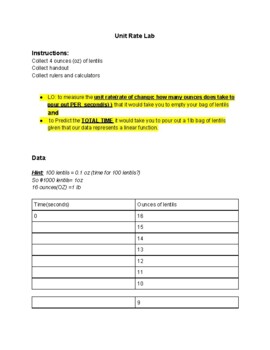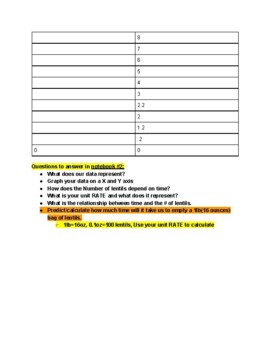Leonel Lerena
1 Follower
Grade Levels
4th - 12th, Homeschool
Subjects
Resource Type
Standards
CCSSHSA-SSE.A.1
CCSSHSF-BF.A.1
CCSSHSF-LE.A.1b
CCSSMP2
CCSSMP4
Formats Included
- PDF
Pages
3 pages
Leonel Lerena
1 Follower
Description
In this Lab students will be able to apply and understand linear questions by collecting data through this short and fun activity. This lab provides lentils as the material used, but feel free to improvise.
The purpose of this is allow students to note the relationship between the amount of lentils(material used) and time while using terms such as outputs, inputs, graphs, data table, and connecting their findings by responding to the questions provided.
The extension to this lab will be provided so stay tuned.
Any questions, clarifications, concerns or even collaborations feel free to reach me at leonellerena@gmail.com
Total Pages
3 pages
Answer Key
N/A
Teaching Duration
90 minutes
Report this resource to TPT
Reported resources will be reviewed by our team. Report this resource to let us know if this resource violates TPT’s content guidelines.
Standards
to see state-specific standards (only available in the US).
CCSSHSA-SSE.A.1
Interpret expressions that represent a quantity in terms of its context.
CCSSHSF-BF.A.1
Write a function that describes a relationship between two quantities.
CCSSHSF-LE.A.1b
Recognize situations in which one quantity changes at a constant rate per unit interval relative to another.
CCSSMP2
Reason abstractly and quantitatively. Mathematically proficient students make sense of quantities and their relationships in problem situations. They bring two complementary abilities to bear on problems involving quantitative relationships: the ability to decontextualize-to abstract a given situation and represent it symbolically and manipulate the representing symbols as if they have a life of their own, without necessarily attending to their referents-and the ability to contextualize, to pause as needed during the manipulation process in order to probe into the referents for the symbols involved. Quantitative reasoning entails habits of creating a coherent representation of the problem at hand; considering the units involved; attending to the meaning of quantities, not just how to compute them; and knowing and flexibly using different properties of operations and objects.
CCSSMP4
Model with mathematics. Mathematically proficient students can apply the mathematics they know to solve problems arising in everyday life, society, and the workplace. In early grades, this might be as simple as writing an addition equation to describe a situation. In middle grades, a student might apply proportional reasoning to plan a school event or analyze a problem in the community. By high school, a student might use geometry to solve a design problem or use a function to describe how one quantity of interest depends on another. Mathematically proficient students who can apply what they know are comfortable making assumptions and approximations to simplify a complicated situation, realizing that these may need revision later. They are able to identify important quantities in a practical situation and map their relationships using such tools as diagrams, two-way tables, graphs, flowcharts and formulas. They can analyze those relationships mathematically to draw conclusions. They routinely interpret their mathematical results in the context of the situation and reflect on whether the results make sense, possibly improving the model if it has not served its purpose.




